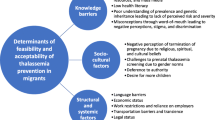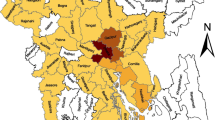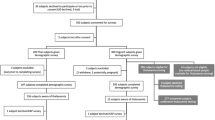Abstract
Hemoglobin disorders which include thalassemias are the most common heritable disorders. Effective treatment is available, and these disorders can be avoided as identification of carriers is achievable using simple hematological tests. An in-depth understanding of the awareness, attitudes, perceptions, and screening reservations towards thalassemia is necessary, as Malaysia has a multi-ethnic population with different religious beliefs. A total of 13 focus group discussions (70 participants) with members of the general lay public were conducted between November 2008 and January 2009. Lack of knowledge and understanding about thalassemia leads to general confusions over differences between thalassemia carriers and thalassemia major, inheritance patterns, and the physical and psychologically impact of the disorder in affected individuals and their families. Although most of the participants have not been tested for thalassemia, a large majority expressed willingness to be screened. Views on prenatal diagnosis and termination of fetuses with thalassemia major received mixed opinions from participants with different religions and practices. Perceived stigma and discrimination attached to being a carrier emerged as a vital topic in some group discussions where disparity in the answers exhibited differences in levels of participants’ literacy and ethnic origins. The two most common needs identified from the discussion were information and screening facilities. Participants’ interest in knowing the severity of the disease and assessing their risk of getting the disorder may imply the health belief model as a possible means of predicting thalassemia public screening services. Findings provide valuable insights for the development of more effective educational, screening, and prenatal diagnostic services in the multi-ethnic Asian society.
Similar content being viewed by others
References
Ahmed S, Saleem M, Sultana N, Raashid Y, Waqar A, Anwar M, Modell B, Karamat KA, Petrou M (2000) Prenatal diagnosis of beta-thalassemia in Pakistan: experience in a Muslim country. Prenat Diagn 20(5):378–383
Ahmed S, Saleem M, Modell B, Petrou M (2002) Screening extended families for genetic hemoglobin disorders in Pakistan. New Engl J Med 347(15):1162–1168
Ahmed S, Green J, Hewison J (2005) Antenatal thalassemia carrier testing: women’s perceptions of “information” and “consent”. J Med Screen 12(2):69–77
Ahmed S, Atkin K, Hewison J, Green J (2006a) The influence of faith and religion and the role of religious and community leaders in prenatal decisions for sickle cell disorders and thalassemia major. Prenat Diagn 26(9):801–809
Ahmed S, Green JM, Hewison J (2006b) Attitudes towards prenatal diagnosis and termination of pregnancy for thalassemia in pregnant Pakistani women in the North of England. Prenat Diagn 26(3):248–257
Ajzen I, Fishbein M (1980) Understanding attitudes and predicting social behaviour. Prentice-Hall, Englewood Cliffs
Alkuraya FS, Kilani RA (2001) Attitude of Saudi families affected with hemoglobinopathies towards prenatal screening and abortion and the influence of religious ruling (Fatwa). Prenat Diagn 21(6):448–451
Angastiniotis M, Kyriakidou S, Hadjiminas M (1986) How thalassemia was controlled in Cyprus. World Health Forum 7:291–297
Armeli C, Robbins SJ, Eunpu D (2005) Comparing knowledge of beta-thalassemia in samples of Italians, Italian-Americans, and non-Italian-Americans. J Genet Couns 14(5):365–376
Atkin K, Ahmad WI (2001) Living a “normal” life: young people coping with thalassemia major or sickle cell disorder. Soc Sci Med 53:615–626
Atkin K, Ahmad WI, Anionwu EN (1998) Screening and counselling for sickle cell disorders and thalassemia: the experience of parents and health professionals. Soc Sci Med 47(11):1639–1651
Becker MH (1974) The health belief model and personal health behavior. Health Educ Monogr 2(4):324–473
Chattopadhyay S (2006) ‘Rakter dosh’-corrupting blood: the challenges of preventing thalassemia in Bengal, India. Soc Sci Med 63(10):2661–2673
Duster T (1990) Backdoor to eugenic. Routledge, New York
Garcia E, Timmermans DR, van Leeuwen E (2008) The impact of ethical beliefs on decisions about prenatal screening tests: searching for justification. Soc Sci Med 66(3):753–764
George E (1998) thalassemia carrier diagnosis in Malaysia. thalassemia diagnostic services (ThalDS). SP-Muda Printing Sdn Bhd. Kuala Lumpur
Gill PS, Modell B (1988) thalassemia in Britain: a tale of two communities. Br Med J 317:761–762
Gorakshakar AC, Colah RB (2009) Cascade screening for β-thalassemia: a practical approach for identifying and counseling carriers in India. Indian J Community Med 34(4):354–356
Lagampan S, Lapvongwatana P, Tharapan C, Nonthikorn J (2004) Health belief model teaching program for thalassemia education in high school students. Chula Med Journal 48(11):725–735
Lakhani N (1999) thalassemia among Asians in Britain. Br Med J 318(7187):873
Modell B, Ward RH, Fairweather DV (1980) Effect of introducing antenatal diagnosis on reproductive behaviour of families at risk for thalassemia major. Br Med J 280(6228):1347–1350
Modell B, Petrou M, Layton M, Varnavides L, Slater C (1997) Audit of prenatal diagnosis for haemoglobin disorders in the United Kingdom: the first 20 years. Br Med J 315(7111):779–784
Petrou M, Modell B, Darr A, Old J, Kin E, Weatherall D (1990) Antenatal diagnosis. How to deliver a comprehensive service in the United Kingdom. Ann NY Acad Sci 612:251–263
Samavat A, Modell B (2004) Iranian national thalassemia screening program. Br Med J 329:1135–1137
Saxena A, Phadke SR (2002) thalassemia control by carrier screening: the Indian scenario. Curr Sci 83(3):291–295
Social Statistics Bulletin Malaysia (2008) Department of Statistics, Malaysia
Tan JAMA, Tan KL, George E, Chow TWP, Tan PC, Hassan J, Chia P, Subramanium R, Chandran R, Yap SF (2004) Molecular defects in the β-globin gene identified in different ethnic groups/populations during prenatal diagnosis for β-thalassemia—a Malaysian experience. Clin Exp Med 4(3):142–147
Tan JAMA, Chin PS, Wong YC, Tan KL, Chan LL, George E (2006) Characterisation and confirmation of rare β-thalassemia mutations in the Malay, Chinese and Indian ethnic groups in Malaysia. Pathology 38(5):437–441
Teh LK, George E, Lai MK, Rahimah A, Zubaidah Z, Tan JAMA (2009) Concurrent inheritance of deletional α-thalassemia in Malays with HbE trait. Malays J Med Hlth Sci 5(2):11–18
Weatherall DJ (2005) The global problem of genetic disease. Ann Hum Biol 32:117–122
Wee YC, Tan KL, Chua KH, George E, Tan JAMA (2009) Molecular characterization of Hemoglobin Constant Spring and Hemoglobin Quong Sze by combine-amplification refractory mutation system. Malays J Med Sci 16(3):23–30
Wong LP (2009) Preventing cervical cancer through human papillomavirus vaccination: perspective from focus group. J Low Genit Tract Dis 13(2):85–93
Zahed L, Bou-Dames J (1997) Acceptance of first-trimester prenatal diagnosis for the haemoglobinopathies in Lebanon. Prenat Diagn 17(5):423–428
Acknowledgment
The study is funded by University of Malaya (research grant FS326/2008C).
Competing interests
The authors declare that they have no competing interests.
Author information
Authors and Affiliations
Corresponding author
Rights and permissions
About this article
Cite this article
Wong, L.P., George, E. & Tan, JA.M.A. A holistic approach to education programs in thalassemia for a multi-ethnic population: consideration of perspectives, attitudes, and perceived needs. J Community Genet 2, 71–79 (2011). https://doi.org/10.1007/s12687-011-0039-z
Received:
Accepted:
Published:
Issue Date:
DOI: https://doi.org/10.1007/s12687-011-0039-z




